
//RACES//UNITS//BUILDINGS//CHEATS//SPELLS//
//WALKTHROUGH//
//GO TO Disciples II: Blades of War//
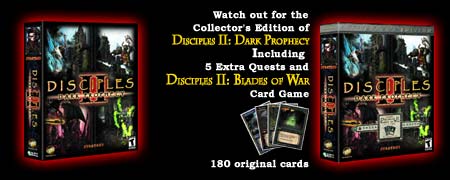
Disciples: Legacy Rules
"Disciples: Legacy" is based on the Disciples series of computer games. Players each control three parties of adventurers struggling for survival. Resources are few, and most will die, but the brave shall live on and be reborn.
"Disciples: Legacy" draws many elements from the "Disciples II: Blades of War," a customizable card game released by Strategy First.
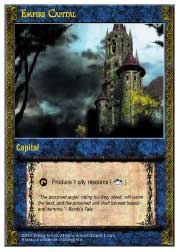
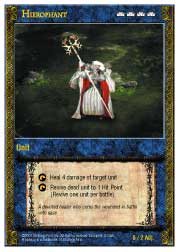
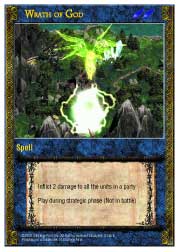
RULES
Disciples: Legacy is customizable strategic card game built specifically for
the CCG Workshop, but it draws heavily from art and some ideas found in the
"Disciples II: Blades of War" CCG released by Strategy First. All copyrights
for all artwork used in Disciples: Legacy are owed by Strategy First. If you
enjoy Disciples: Legacy, you will probably also enjoy the Disciples series
of computer games published by Strategy First. Many aspects of Disciples:
Legacy are similar to the computer games, especially the tactical battles
between parties.
In order to be fully enjoyed, Disciples: Legacy should be played on CCG
Workshop with at least 1024x768 resolution.
Spending and Tapping:
There are two primary concepts players need to understand before they can
truly understand Disciples: Legacy. These two concepts are called "Spending"
and "Tapping," and they are actually quite similar.
First, let's look at Tapping. During a Battle, one player will choose a Unit
or Leader to attack with, and then the other player does the same. This
continues until all of the Units and Leaders in the battle have attacked. In
order to keep track of which Units and Leaders have already attacked during
that Battle Round, we turn the Unit/Leader cards 90 degrees clockwise to
show that they've already been used during that Battle Round. This is called
"Tapping". When the game instructs you to "tap" a card, it means turn it 90
degrees clockwise. When you're instructed to "untap" a card, turn it
right-side up, the way it would normally be played.
Sometimes you'll see something that look like this on a card:
(T): <ability text here>
The (T) means "Tap this card", so that effect means that if you tap that
card, the effect happens. However, the card must be untapped in order for
you to tap it. If it was already tapped, then you're out of luck. Different
cards tap for different reasons and at different times. Units and Leaders
tap when they attack an enemy Unit/Leader during a Battle, but Cities tap
when they provide resources. The common thread is this: You tap things to
show that they've been used, and when something is tapped, you can't tap it
again until you untap it.
"Spending" is similar to tapping, but it is only used to keep track of one
thing: Which Leaders have acted that turn during the Strategic Phase (rather
than in battle.) To show that a Leader is spent, place an Spent Token on
that Leader. Sometimes you'll see an effect on a Leader that looks like
this:
(S): <ability text here>
The (S) means "Spend this card. So if you "Spend" that card (by placing a
spent token on it), then that effect activates. These are often referred to
as '(S) abilities'.
During the Main Phase of a turn, players alternate using (S) actions until
all Leaders in play are spent, and then the next turn begins.
Remember:
-'Tapping' a card may happen at different times, depending on the sort of
card it is. See the sections on the specific card types for more
information.
-'Spending' a Leader can only happen as an action on your turn. You may not
spend a Leader during a Battle.
-You can not tap a card that is already tapped, and you can *not*
spend a card that is already spent.
-You can tap a card that is spent, and you can spend a card that is
tapped. (Although the latter doesn't really ever happen.)
Before Your First Game:
Disciples: Legacy is different from most card games because players have
control over many cards at the beginning of a game. This can cause new
players to become confused or frustrated during their first game if they try
to jump right in, and your opponent may become frustrated while waiting for
you to assemble your Starting Army into three Parties.
Therefore, we strongly suggest that new players become familiar with the
game by spending some time reading their cards and that they practice
building parties using the CCG Workshop, or that they find a patient and
experienced player to show them the ropes.
Starting a Game:
Players will play with 2 decks -- one Army Deck and one Reserves Deck. Both
players complete these steps simultaneously.
Deploy Army Decks:
The Army Deck represents your starting army. It includes all of the cards
and units that you own at the begining of the game, as well as your race's
Capital. Each player uses their own individual Army Deck. Army decks must
contain exactly 18 city resources (C) worth of Leader, Unit, and Item cards,
plus their Capital. See "Deck Construction" near the bottom of this document
for more information.
Players place all cards from their Army Deck into play. The Players then
assemble their Leaders, Units, and Items from their Army Deck into three
Parties. See the "Parties/Formation" section below for more information on
legal Party Formations. It is strongly suggested that you decide your
starting formations before you start a game to speed up play.
Draw Reserves Decks:
Once a Player has arranged the cards from his or her Army Deck into three
Parties, that player draws his or her entire Reserves deck into his or her
hand.
The Reserves Deck represents the forces you can bring into play during a
game. The Reserves Deck has one copy of every card that you can bring into
play during a game. Any time you wish to bring a new unit into play, you
just make a copy of the card from your hand, meaning that each card in your
hand may be used any number of times. Reserves decks must contain exactly 12
cards. See "Deck Construction" near the bottom of this document for more
information.
When both players have completed these two steps, the first turn begins.
Winning:
The object of the game is to elminate all of your opponent's Parties. You
can do this in a number of ways, such as attacking and defeating their
parties directly, by casting spells, or by stealing their resources and
outnumbering them.
If at any point a player has no living Leaders or Units, the other player is
the winner of the game.
Cards:
This section will explain what the various cards are. It will have
pictures of the card types and what exactly the various parts of the card
mean.
Leaders:
Leaders can use (S) abilities. (S) abilities are written as follows:
(S): <Ability Text>
To use an (S) ability, place a 'spent' token on that leader to do whatever
the effect tells you to do. 'Spent' Leaders may not use an (S) ability. (S)
abilities may only be used as player actions outside of Battle.
Leaders also follow all rules of Units, except that a Leader may not be in a
party with another Leader.
Like Units, Leaders may be tapped as a Battle Action to deal damage to the
enemy party. Leaders may also tap as a Battle Action to use an equipped item
(assuming they have any).
There are two types of Leaders: Major Leaders or Minor Leaders.
Major Leaders represent the three starting Leaders of each player's
Army. Major Leaders have a 'Leadership' statistic that dictates the maximum
number of Units that may be in that Major Leader's Party. For example, if a
Major Leader card says "Leadership: 3", then that Leader's Party may contain
up to three Unit cards.
Minor Leaders represent heroes that may be recruited to aid the
player's cause. Thief, Rod Planter, and spell-summoned Leaders are all
examples of Minor Leaders. Minor Leaders always have an innate "Leadership:
0" ability, meaning they may not have any Units in their Party.
Spells and abilities may not target or affect Minor Leaders, unless that
effect specifically says 'Minor Leaders'. Minor Leaders *can*, however, be
attacked by enemy Major Leaders.
Each player may control no more than 3 Major Leaders and 2 Minor Leaders
(including summoned Minor Leaders) at any time.
Units:
Units have one purpose in life, and that is to fight. Although units make up
the most common card type, their role is limited to that of fighting
soldiers that travel with Leaders.
Units must always be in a party with exactly one Leader at all times.
Although Units may sometimes be targeted outside of Battle (by a thief, for
instance,) they only time Units themselves may ever act is during a Battle.
See the "Battles" section below for more information on how Units act in
Battle. Also, see the "Parties (and Formations)" section below for more
information on how Units fit into Party Formations.
Unit cards have their text that looks like this in the bottom right of the
card:
5 / 2 adj
This means that the units has 5 HP, an Attack value of 2, and that it has an
adj-style attack. See below for more information on what these statistics
mean.
MULTI-RACE RULE: Leaders may only recruit Unit and Minor Leader cards
of the same race as a City or Capitol that Player controls. If you are only
using cards of one race, this does not affect you.
Giants:
Some units are also Giants. Giants behave exactly like normal units, except
that they occupy 2 slots in your party.
Giants must occupy both a front-row slot and a back-row slot in the same
column, and Giant cards should be placed on the playmat such that they are
occupying both slots. A party may never have more than 2 giants. (INSERT
PICTURE)
City Cards:
City Cards represent cities under a Player's control which allow that player
to recruit new units/Leaders and to buy items.
Major Leaders may bring new cities into play or steal enemy cities. See
"Leaders" section below for more detail.
Capital:
A Capital is the same as a city, except that Capitals can never be attacked,
stolen destroyed, or duplicated. Each capitol a different unique ability
that fits the personality of that race. Alternative capitals will most
likely be released in future expansions.
Mana Cards:
As a Rod Planter's (S) action, a Player may put a Mana card of any color
into play from his or her hand. This ability cannot be used if a player has
no Mana cards in his or her hand.
Mana cards are used to cast Spells. See the "Spells" section below for more
detail.
Item Cards:
Item Cards represent items and potions that Leaders carry to help them win
Battles. A Leader may never have more than one copy of an item. If a Leader
ever has more than one copy of an item for any reason, place every copy of
that card except for one in the Discard Pile.
When an item says "Tap Leader: <effect text here>", then the Leader may tap
to use that ability as if it were its own (T) ability.
MULTI-RACE RULE: Leaders may only purchase Item cards of the same
race as a City or Capitol that Player controls. If you are only using cards
of one race, this does not affect you.
Spell Cards:
Spell Cards represent spells that your Rod Planters can cast. To cast a
Spell, a must spend a Rod Planter as an action. That Player must have enough
Mana Cards to meet the resource cost the Spell Card. For example, if a Spell
Card has two red mana symbols (R) in its upper-right corner, it means the
player must own two Red Mana cards (which provide (R)) when you cast the
spell. A Player cannot cast a spell that he or she cannot pay for.
Some Spell cards represent Minor Leaders that are summoned to aid the
Player. Only one copy of a given Summon card may be in play at a time. If
you cast a Summon Spell to summon a Minor Leader you already control, you
may heal all HP on that Leader.
A player may only cast one spell per turn, even if their Rod Planter becomes
untapped somehow.
MULTI-RACE RULE: Rod Planters may only cast a Spell if that Spell
shares its race with a City or Capital card under its owner's control. If
you are only using cards of one race, this does not affect you.
Tapping cards for City Resources, (C)
Players may tap Capitol and/or City cards to generate City Resources, (C)
(assuming they say so on the card.)
When tapping a card for city resources, a player must use all (C) generated
by that card immediately, or it is lost. The only exception to this rule is
that during the Healing Phase -- Any extra (C) generated during Step 1 of
the Healing Phase can also be used during Step 3.

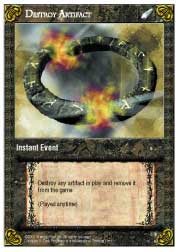

Parties (and Formation):
A Party is a group of 1 Leader and up to 5 Units that travel together to
accomplish goals.
Parties are assembled into 'formations,' where Units and Leaders are each
placed into one of six slots are arranged like this:
1 2 3 <--Front Row 4 5 6
Parties have a front row and a back row. The front row is the row closest
to your opponent's play area.
Only one Unit/Leader may occupy any given slot at a time. You may alter the
formation of any of your Parties' at any time except during Battle.
Giant Unit cards require a slot in the front row and a slot in the back row
in the same column. In the example above, a Giant card could only fit into
slots 1&4, or 2&5, or 3&6. They are always treated as occupying both slots,
but you use its front slot for purposes of determining adjacency (see
below).
When two Parties are in battle, they are considered to be aligned with the
enemy Party as follows:
F E D C B A <--Opponent's Front Row --------- 1 2 3 <--Your Front Row 4 5 6
(The numbers represent your party, and the letters represent the opposing
party)
Many Units and Leaders may only attack enemy Units and Leaders adjacent to
them. A unit can use an adjacent attack against another unit unless it
breaks on of these rules:
-There cannot be any rows containing any living units between the attacking
and targetted units.
(ex: In the diagram above, 4 could not use an adjacent attack against C
unless 1, 2, and 3 were dead)
-A unit on the far left cannot attack a unit on the far right (and vice
versa) unless there are no other living units in the target unit's row.
(ex: In the diagram above, 1 could not use an adjacent attack against A
unless C and B were dead.)
As a general rule, you'll typically want to keep Units/Leaders with "Adj"-style
attacks in the front row, and units with "Any"- and "All"-style attacks in
the back row. It is also generally best to play stronger units in the
middle, and weaker units on the sides. But keep in mind that the ideal
formation of a party depends on the exact nature of the Units/Leaders in
that Party. Experiment to find the best combination for your Parties!
TURN ORDER:
Untap/Unspend Phase:
Untap all Capitols and Cities. All Spent Counters are removed from all
cards.
Healing Phase:
There are 3 steps during the Healing Phase.
Step 1) Each player may revive any number of dead Units/Leaders to 1 HP, but
each player must pay (C) for each Unit they wish to revive, or (C)(C) for
each Leader they wish to revive. (Cards in the Discard Pile may not be
revived in this way.)
Step 2) All face-up (i.e. living) Units and Leaders heal 1HP.
Step 3) Each player may pay any number of (C). For each (C) that a Player
pays, that Player may heal 2HP on a Unit/Leader of their choice.
Strategic Phase:
Starting with the player whose turn it is (according to gEngine), each
player alternates taking actions until neither player can take any more
actions. If one player runs out of actions, the other player may continue
taking consequetive actions until they can no longer take any actions
themselves.
Once each turn, each player may choose to 'pass' as their action. If a
player passes, the next player may not pass their action if possible.
As an action, you can do one of the following:
-Use an (S) ability of a Leader.
-or you can Pass (once per turn, and not immediately after another player
passed.)
Minor Leaders may only perform (S) abilities listed on the cards themselves.
Major Leaders, however, have several innate (S) abilities that any Major
Leader may use.
(S): Recruit a City
(S): Recruit a Thief or Rod Planter
(S): Recruit a Unit
(S): Shop for Items
(S): Trade with another Major Leader
(S): Attack (to fight) any enemy party
(S): Attack (to steal) any City or Mana
(S): Block any unblocked attack by an enemy Party. This ability may only be
used when an enemy party is attacking one of your parties, cities, or mana.
When you block an enemy Party, a Battle occurs. See the "Battles" section
below for more information.
(S): Recruit a New Major Leader (see "Replacing Dead Major Leaders" section
below)
End of Turn:
The turn ends once all leaders in play are 'spent'.
Major Leader (S) Actions
Recruiting A City:
As an (S) action, a Major Leader may place a copy of a city card from their
hand into play under his or her control.
Recruiting A Thief or Rod Planter:
As an (S) action, a Major Leader may recruit a Thief or Rod Planter from
their hand into play. If a player recruits a Thief or Rod Planter while that
player already controls a card of that name, the old card is discarded
immediately.
Recruiting A Unit:
As an (S) action, a Major Leader may recruit a Unit to join its Party. If
there are more Units in the Party than the Leader's Leadership value, or if
there isn't enough room in the formation for the Leader and all Units, then
that Player must immediately discard enough Units from that Party until it
is legal.
Shopping:
As an (S) action, a Major Leader may shop for Items. When a Player declares
that their Leader is shopping, that Player chooses up to three different
items in his or her hand and places copies of those items into play, owned
by that Leader.
When a Leader goes shopping, that Leader may apply 1 free City Resource (C)
toward any purchases, but that player must otherwise tap a number enough
Cities to satisfy the cost of all Items being bought. A Player cannot buy
more items that that Player can afford (taking into account the free (C)
resource).
Trading:
As an (S) action, a Major Leader may trade items and units with another
Major Leader owned by the same player. When a Party trades with another, the
Player may reallocate any items owned by either Leader amongst those two
Leaders, as long as there are no illegal formation issues.
Attacking:
As an (S) action, a Major Leader may attack an enemy City, Mana, or Party.
If a Leader attacks and is unblocked, then the following happens:
-If the Attacking Player was attacking a City or Mana, that Player takes
control of the that City or Mana.
-If the Attacking Player was attacking an Enemy Party, the Attacking Player
engages in Battle with the target Party.
However, if the Leader's attack *was* blocked by an Enemy Party, then a
Battle occurs. See the "Battles" section below for more information.
Blocking:
Blocking is unlike other (S) actions in that you declare a block immediately
after an opponent attacks one of your cards or Parties. You must still place
a spent counter on the Leader that is blocking. Once you declare that you
are blocking an enemy attack, a Battle begins between the attacking and
defending Parties.
Replacing Major Leaders
As an (S) action, a Major Leader may recruit a new Major Leader to replace
one that fell earlier in Battle. To use this ability, the player takes a
Major Leader card from their Discard Pile and pays that Leader's recruit
cost and. That Leader then returns to play with full health as the only
member of a new Party. (The Leader should be placed in the same area of the
Playmat that it occupied while previously alive.) Replaced Major Leaders are
returned to play Spent.
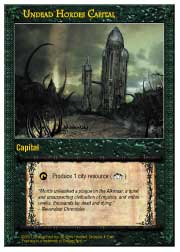
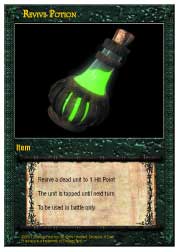
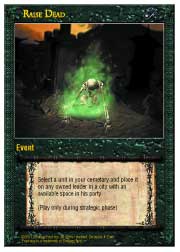
BATTLES
Battles can occur in one of two ways:
1) A Party blocks an enemy Party's attack.
2) A Party attacks an enemy Party and is not blocked.
Only attacks (on Cities, Mana, and Parties) may be blocked. No other action
may be blocked.
The two parties that are battling are referred to as 'Battle Parties.'
Battles have the following steps:
Step 1:
The Attacking Player has one final opportunity to rearrange his or her Party
into a new legal formation.
Step 2:
The Defending/Blocking Player has one final opportunity to rearrange his or
her Party into a new legal formation.
Step 3:
The Attacking Player may choose to retreat. (See "Retreating" section
below.)
Step 4:
The Defending Player may choose to retreat. (See "Retreating" section
below.)
Step 5:
A Battle Round Begins.
Round 1, 3, ...: Defending Player gets first Battle Action this Battle
Round.
Round 2, 4, ...: Attacking Player gets first Battle Action this Battle
Round.
(Note: There are usually only 2 Battle Rounds in a Battle)
Starting with the appropriate Player, Players alternate taking Battle
Actions.
As an action, a player may do one of the following:
- Tap an untapped Unit or Leader to deal attack damage immediately as per
its attack style. (See "Attacking with a Unit/Leader" section below.)
- Tap an untapped Unit or Leader to use one of its abilities (assuming it
has any)
- Pass (once per Combat Round, and not immediately after another player
passed.)
If one player runs out of untapped Units/Leaders, the other player may
continue taking consequetive Battle Actions until they have no more untapped
Units/Leaders.
If one player runs out of living Units/Leaders in their Battle Party,
proceed immedately to Step 7.
Step 6:
All Units and Leaders in the battling parties untap (even if dead).
-If this is the first round of battle AND both players still have living
units in the battling parties, return to step 3.
-If this is the second round of battle OR there are no more living units in
at least one of the parties, go to step 7.
Step 7:
Battle is now over.
If the Attacking Party was blocked by an enemy Party, then the Attacking
Party still achieves its objective if *ANY* of the two following conditions
are met:
1) The Blocking Party retreated
OR
2) The Blocking Party has no living Units/Leaders *AND* the Attacking Party
does still have any living Units/Leaders.
If either of these conditions are met, then the attack continues as if
unblocked:
-If the Attacking Player was attacking a City or Mana, that Player takes
control of the target City or Mana.
-If the Attacking Player was attacking an Enemy Party, the Attacking Player
may decide to engage in Battle with the intended target Party or to cancel
the attack.
Attacking with a Unit/Leader
Each Unit or Leader has the following innate ability:
(T): Deal Damage to Enemy Leader(s)/Unit(s)
This means that during Battle, a player may choose to Tap any Untapped
Unit/Leader to deal damage to at least one member of the opposing Battle
Party. The number of targets and position of valid targets are determined by
its attack style. There are three styles of attacks:
Adj: Adj-style (or "Adjacent") attacks are Melee attacks that can
attack nearby enemies. See the "Parties (and Formation)" section above for
specific information on which enemy units can be targetted by an Adj-style
attack. To use an Adj-style attack, tap the Unit/Leader making the attack
and deal an amount of damage to the target enemy Leader/Unit equal to the
attack statistic of the attacking Unit/Leader.
Any: Any-style attacks are attacks that can target any Unit/Leader in
the opposing Battle Party. To use an Any-style attack, tap the Unit/Leader
making the attack and deal an amount of damage to the target enemy
Unit/Leader equal to the attack statistic of the attacking Leader/Unit.
All: All-style attacks are attacks that target all Units/Leaders in
the opposing Battle Party. To use an All-style attack, tap the Unit/Leader
making the attack and deal an amount of damage counters to all Units/Leaders
in the oppsing Battle Party equal to the attack statistic of the attacking
Leader/Unit.
NOTE: During battle, an effect or attack may never target a
Unit/Leader outside of that Battle unless it specifically says otherwise.
Damage/HP:
In Disciples: Legacy, 'damage' represents the amout of damage that a give
Unit/Leader takes (or has taken), usually during Battle.
'HP', on the other hand, refers to the amount of damage a Unit/Leader can
take before that Unit/Leader dies. (HP is a long-standing gaming term that
stands for 'Hit Points', or how many hits a thing can take before it dies.)
Damage and HP are opposites of one another. When a Unit/Leader is dealt 1
point of damage, then they lose 1 HP.
So for example, the 'Possessed' card has a Max HP stat of 5. This means that
when it enters play, it has 5 HP, and 0 damage. If the Possessed takes a
point of damage, it would then have 1 damage and 4 HP, but it's MAX HP is
still 5 (and will always remain at 5 unless another card specifically
affects its MAX HP).
A Unit/Leader's MAX HP never changes unless an effect specifically says it
does. If a Unit/Leader's MAX HP is raised or lowered, the amount of damage
on that Unit/Leader is unaffected.
When a Unit/Leader takes damage, Players must put a number of damage
counters on that card equal to the amount of damage it has taken. (As a
alternative which many people prefer, Players may also use dice to represent
damage.)
All Units/Leaders enter play with full HP and no damage.
Dead Units/Leaders:
If at any time a Unit/Leader has taken damage equal to the MAX HP of that
Unit/Leader, then that Unit/Leader is dead until it is revived. To show that
a Unit/Leader is dead, flip that card face down. If that Unit/Leader is
later revived, flip that card face up. Usually, revived Units/Leaders will
have very few HP when they're revived, so be sure to put the appropriate
amount of damage counters on revived Units/Leaders.
Dead Leaders/Units do not heal HP and may not use (T), (S), or passive
abilties.
A Dead Leader may be attacked by an enemy Party if that Leader has any
living Units in its Party.
Wiping Out Parties
If at any time all Units/Leaders in a Party are dead, then that Party is
considered 'wiped out'. All Leaders and Units in that party are placed in
their controller's discard pile.
If a Party was wiped out in Battle, then any items belonging to the wiped
out Leader are given to Leader of the opposing Battle Party if possible. Any
items not taken by the victorious Leader are discarded.
NOTE: In case it's not obvious, losing a party is bad. Real Bad.
Likewise, defeating a party is good. Real Good. Do what it takes to not lose
your parties, and usually that means retreating.
Retreating:
If a Player chooses to retreat, that Player may not perform any Battle
Actions during that Battle Round. The other player may then perform two
Battle Actions before the retreating Party succesfully escapes.
If all Units/Leaders of the Retreating Party are killed before they
successfully escape, then the Battle is resolved as a normal Battle. See
Step 7 in the "Battles" section above.
If the Retreating Party still has at least one living Unit/Leader when it
successfully escapes, then:
-If the Attacking Player was attacking a City or Mana, that Player takes
control of the target City or Mana.
-If the Attacking Player was attacking an Enemy Party, the Attacking Player
may decide to engage in Battle with the intended target Party or to cancel
the attack.
NOTE: Strategic use (or misuse) of the Retreat option can make the
difference between winning or losing an entire game. Try to learn when it's
best to Retreat and when to fight.
Deck Construction:
Army Deck:
Your Army deck contains all of the cards that you will start the game with.
All cards in your Army Deck must be of the same race. (Clans, Empire,
Legions, or Hordes)
The Army deck must contain Leaders, Units, and Items that have a combined
cost of no more than 18 City Resources (C).
Army Decks MUST contain:
-1 Capital Card
-3 Major Leader Cards
Each Major Leader Card must be different from the others. All included Major
Leader cards must be of the same race as your Capital.
-X Unit and Item Cards
A player may include any number of Unit and Item cards, but the total cost
of the deck (including Leaders) must not exceed 18 City Resources (C).
Army Decks CANNOT contain:
-City cards
-Mana cards
-Spell cards
-Minor Leader cards
-Any card whose race is different from the race of your capital
Reserves Deck:
The Reserves deck must contain exactly 12 unique cards.
The Reserves deck must contain at least one City card.
The Reserves deck MAY contain:
-City cards
-Mana cards
-Minor Leader cards
-Unit cards
-Item cards
-Spell cards
The Reserves deck MAY NOT contain:
-Major Leader cards
-Capital cards
Cards in the Reserves deck may be from any race, but keep the following
rules in mind when constructing your Reserves deck:
-Rod Planters may only cast spells that shares its race with a city card its
owner controls.
-Leaders may only recruit Unit and Minor Leader cards of the same race as a
City or Capitol that Player controls.
-Leaders may only purchase Item cards of the same race as a City or Capitol
that Player controls.
At the beginning of the game, you draw the entire Reserves Deck into your
hand. Whenever you wish to play a card from your hand, you make a copy of
that card. That means that you can use the cards in your Reserve Deck any
number of times during a game.
Glossary:
Here are what the various symbols and terms of Disciples: Legacy mean:
(B) -- BLACK MANA RESOURCE
(C) -- CITY RESOURCE
(R) -- RED MANA RESOURCE
(S) -- SPEND ACTION (OR REACTION)
(T) -- TAP ACTION (OR REACTION)
(U) -- BLUE MANA RESOURCE
(W) -- WHITE MANA RESOURCE
Adj-Style Attack -- Units/Leaders with 'adj'-style attacks may only
attack adjacent enemy Units/Leaders in Battle.
All-Style Attack -- Units/Leaders with 'all'-style attacks may attack
all enemy Units/Leaders in Battle with one attack.
Any-Style Attack -- Units/Leaders with 'any'-style attacks may attack
any single enemy Unit/Leader in Battle.
Army Deck -- Your Army Deck contains all Leaders, Units, and Items
that are under your control at the beginning of the game.
Battle Round -- A Battle Round is similar to a Turn, except that it
measure the time it takes for all units to attack the enemy Party in Battle.
Each Battle ends after 2 Battle Rounds.
Capital -- Capital cards are similar to Cities, but they may never be
attacked, stolen, or destroyed. Capitals have additional abilities on them
that are unique to each race.
City -- City cards are used to buy new Units, Leaders, and Items, as
well as to heal Units.
Formation -- Parties are arranged into legal Formations, which
represent what units are standing where during Battle. Formations affect
which Units may target other Units in Battle.
Giant -- Some Units are Giants. Giants require an entire column (2
slots) in a party formation due to their size, but they tend to be more
powerful.
HP -- HP stands for Hit Points. This is an old gaming term that
measures the number of hits a thing can take before it is killed/destroyed.
When a Unit/Leader takes damage they lose HP.
Item -- Item cards represent artifacts and items used by Leaders.
Items can be obtained by Shopping, or by wiping out an enemy Party.
Leader -- There is always exactly one Leader in a Party. In the case
of Minor Leaders, they represent the entire Party, as they may not have any
Units in their Party.
Mana -- Mana cards are used to cast Spells. A player may not cast a
spell unless that player owns the correct Mana cards to cast the spell.
Party -- A group consisting of exactly 1 (Major or Minor) Leader and
up to 5 Units. Parties must always be arranged in proper Formation.
Reserves Deck -- Your entire Reseves Deck is drawn into your hand at
the beginning of the game, and represents extra Items, Spells, Mana, Units,
Leaders, and Cities that you may bring into play during a game.
Retreat -- During Battle, either Party may choose to retreat. If a
Party does Retreat, the opposing Battle Party may take 2 'free' Battle
Actions before the retreat is successful.
Revive -- Players may revive dead Units/Leaders during the Healing
Phase or by using an Item or some other effect. Revived Units/Leaders
usually have few HP when they are revived.
Rod Planter -- Rod Planters are Minor Leaders that can recruit Mana
and cast spells. Players cannot cast spells without Rod Planters and Mana.
Shopping -- Major Leaders may go shopping as an (S) action in order
to obtain Items.
Spell -- Spell cards represent magic that can be cast by players.
Casting a spell requires an unspent Rod Planter and enough mana to satisfy
the Spell's cost.
Spend -- To place a spent counter on a card, usually during an (S)
action. You may not spend a card if it is already spent.
Tap -- To rotate the card clockwise 90 degrees to show that it's been
used. You may not tap a card if it is already tapped.
Thief -- Thieves are special Minor Leaders that are helpful in
various ways.
Turn -- A turn is the period of time from one Untap/Unspend Phase
until the next Untap/Unspend Phase. Most games are usually around 5 turns
long.
FAQ
Q: I can recruit more than one city a turn, right?
A: Correct. There is no limit to the number of cities that you can
recruit in a turn, provided that you have the leaders to spend.
Q: Do Giants count as 2 units in a party?
A: No. Giants count as 1 unit in a party. However, they do require
both the front-row slot and the back-row slot in the same column.
See the "Parties (and Formations)" section of the rulebook for more details.
Q: During Step 3 of the healing Phase, I have 2 units that each have 1
point of damage. Can I pay (C) to heal 1 pt to both?
A: No. Each (C) you pay lets you heal 2 HP to a single target. If you
want to heal 2 seperate targets, you must pay (C)(C).